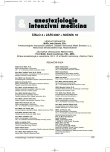Single-shot paravertebral block in children – the initial experience
Authors:
E. Berta 1; J. Špaňhel 1; O. Šmakal 2; T. Gabrhelík 1; V. Smolka 3; B. Bertová 1; H. Špaňhelová 1; H. Fiala 1
Authors‘ workplace:
Klinika anesteziologie a resuscitace Fakultní nemocnice Olomouc
1; Urologická klinika Fakultní nemocnice Olomouc
2; Dětská klinika Fakultní nemocnice Olomouc
3
Published in:
Anest. intenziv. Med., 18, 2007, č. 4, s. 216-220
Category:
Anaesthesiology - Original Paper
Overview
Objective:
To study the effectiveness of a single-shot paravertebral block in children following major urologic surgery. Both multiple-level and continuous paravertebral blocks had already been successfully used for postoperative analgesia in children.
Design:
Prospective, observational, partly observer-blinded trial.
Setting:
Department of Anaesthesia and Intensive Care, University Hospital.
Materials and methods:
A paravertebral block was performed at Th10–12 level in 8 children (median age 9.8 months [range 3.2–17.1]) undergoing renal surgery during the preparatory phase before a pilot study. At the end of surgery the patients were administered 0.5 ml/kg of levobupivacaine 2.5 mg/ml with epinephrine 5 mcg/ml, loss-of-resistance technique. Anaesthesia and postoperative care were standardized. Postoperative pain was assessed hourly or when a patient complained of pain using the FLACC score and a fourgrade nurse score during the first 12 hours after admission to the intensive care unit. The duration of postoperative analgesia was defined as the interval between administering the paravertebral block and the first supplemental administration of an opioid. The incidence of paravertebral block complications and postoperative vomiting were also recorded.
Results:
The paravertebral block was successfully performed in 7 patients (87.5%). The median duration of analgesia was 435 min (range 210–720 min) with 2 children not requiring any supplemental analgesia during the 12-hour observation period. A vascular puncture was observed in 1 child (12.5%) and postoperative vomiting occurred in 2 children (25%). All the complications were considered minor.
Conclusions:
The initial experience shows that a single-shot paravertebral block is a safe method providing children undergoing renal surgery with long-lasting postoperative analgesia.
Key words:
paravertebral block – children anaesthesia – postoperative analgesia – regional anesthesia
Labels
Anaesthesiology, Resuscitation and Inten Intensive Care MedicineArticle was published in
Anaesthesiology and Intensive Care Medicine

2007 Issue 4
Most read in this issue
- Non-heart-beating donors
- The First Registered Anaesthetic Nurse in Czechoslovakia: D. S. Alena Stárková-Palečková
- Notes on the pathophysiology of postoperative delirium
- The early days of ether anaesthesia in Moravia in February 1847
